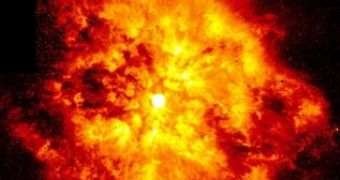The mass of a baby star has been measured by scientists for the first time, the event revealing important information for the understanding of stellar evolution, NASA astronomers declared.
L1527 IRS is one of the youngest stars in the universe and was estimated to have a current mass five times smaller than that of the sun.
Caught in full process of growing, its mass is supposed to be increasing in the years to come, Space reports.
“There's five times more material surrounding it that could be incorporated in [the star]. There is still a lot of room to grow, so to say,” declared John Tobin, researcher at the National Radio Astronomy Observatory in Virginia.
The process of a star formation generally consists of dense regions inside gas clouds falling into plasma spheres. Particles from within the gas cloud flow out and turn into a protostar, a dense cloud that continues to collapse and eliminate gravitational binding energy. The protostar is usually surrounded by a belt of dust and gas, which plays a central role in the formation of planets.
“There is a rotationally supported disk around this protostar. It lets the material hang out long enough for the planet formation process,” Tobin explained.
Research shows that the exterior disk of particles is present in about 90 percent of the known young stars, which led scientists to the conclusion that it represents a common phenomenon in every baby star's evolution.
Scientists say further research is to be undertaken at the Atacama Large Millimeter Array in Chile, a telescope which allows detailed view of the universe impossible to be obtained through visible or infrared light.
“We want to get a more detailed view of the structure of the rotating disk,” said Tobin.
“We're also trying to look at more young protostars to find more disks like this. You can get a big picture view of everything that’s going on.”

 14 DAY TRIAL //
14 DAY TRIAL //